Themed collection Polymer Self-Assembly

Polymer self-assembly: a web themed issue
Guest editors Feihe Huang, Rachel O'Reilly and Steven C. Zimmerman introduce this web collection highlighting recent achievements in the field of polymer self-assembly.

Chem. Commun., 2014,50, 13415-13416
https://doi.org/10.1039/C4CC90367F
Cooperative self-assembly of porphyrins with polymers possessing bioactive functions
This review covers recent research on design strategies for the cooperative self-assembly of porphyrins with polymers and its implementation as bioactive assembly.
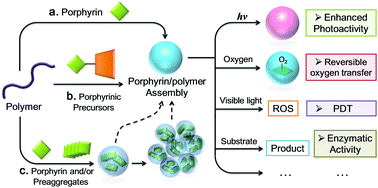
Chem. Commun., 2016,52, 13543-13555
https://doi.org/10.1039/C6CC05449H
Enzyme-responsive polymer assemblies constructed through covalent synthesis and supramolecular strategy
Enzyme-responsive polymer assemblies have continually gained progress through the introduction of new enzymes and the development of new strategies for their preparation. In addition, kinetic studies will pave the way for tuning the response rate in a controlled manner.

Chem. Commun., 2015,51, 996-1003
https://doi.org/10.1039/C4CC05878J
Antibacterial polymeric nanostructures for biomedical applications
A topical review on recent advances in the research and applications of antimicrobial polymeric nanostructures, such as silver-decorated polymeric nanostructures, and polymeric micelles and vesicles based on antimicrobial polymers and antimicrobial peptides.
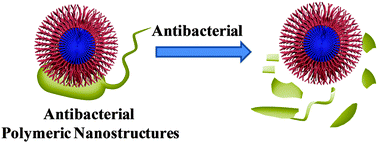
Chem. Commun., 2014,50, 14482-14493
https://doi.org/10.1039/C4CC03001J
Threaded macromolecules as a versatile framework for biomaterials
In this feature article, the recent progress in biomaterial application of threaded macromolecules including polyrotaxanes such as drug delivery and gene delivery is described.
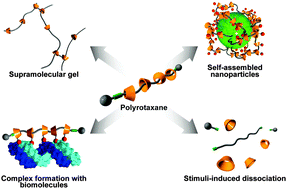
Chem. Commun., 2014,50, 13433-13446
https://doi.org/10.1039/C4CC03709J
Self-assembly of random copolymers
The versatility of random copolymer based self-assembly to provide diverse morphologies and their utility are discussed.
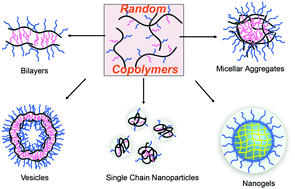
Chem. Commun., 2014,50, 13417-13432
https://doi.org/10.1039/C4CC03688C
Self-assembly and applications of poly(glycidyl methacrylate)s and their derivatives
Poly(glycidyl methacrylate)s self-assembled to form micelles, capsules, hybrid materials and nanoparticles, showing applications in drug and gene vectors, solubilizing agents, etc.
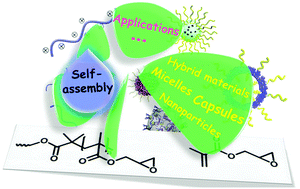
Chem. Commun., 2014,50, 13201-13215
https://doi.org/10.1039/C4CC03036B
Ferrocene-based supramolecular structures and their applications in electrochemical responsive systems
In the field of electrochemical stimuli, ferrocene and its derivatives were widely studied with different host molecules, mainly including cyclodextrin, cucurbituril, pillararene and calixarene. This article generally summarizes the recent work regarding the host–guest interactions between ferrocene derivatives and their host molecules, as well as various supramolecular systems based on these interactions.
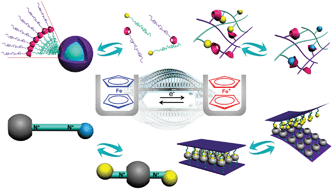
Chem. Commun., 2014,50, 13005-13014
https://doi.org/10.1039/C4CC05192K
Pillararene-based supramolecular polymers: from molecular recognition to polymeric aggregates
This Feature Article covers recent research endeavors of the marriage between pillararene-based host–guest pairs and supramolecular polymeric assemblies.
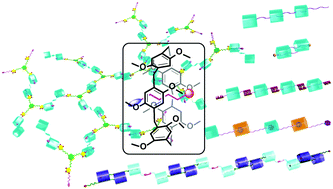
Chem. Commun., 2014,50, 12420-12433
https://doi.org/10.1039/C4CC03170A
Dendronized supramolecular polymers
Supramolecular polymers from dendritic motifs combine the dynamic nature of supramolecular construction and inherent features from covalent dendronized polymers.

Chem. Commun., 2014,50, 12221-12233
https://doi.org/10.1039/C4CC03119A
Self-assembly of supramolecularly engineered polymers and their biomedical applications
Self-assembly behavior of supramolecularly engineered polymers and their biomedical applications have been summarized.
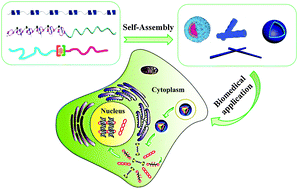
Chem. Commun., 2014,50, 11994-12017
https://doi.org/10.1039/C4CC03155E
Block copolymer self-assembly controlled by the “green” gas stimulus of carbon dioxide
CO2 can act as a “green” stimulus to precisely tune the self-assembly of block copolymers.
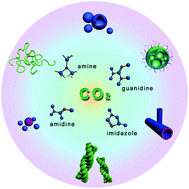
Chem. Commun., 2014,50, 11631-11641
https://doi.org/10.1039/C4CC03412K
Noncovalent interaction-assisted polymeric micelles for controlled drug delivery
Various individual or synergistic noncovalent interactions were employed to mediate polymeric micelles for controlled drug delivery.
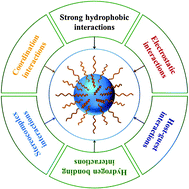
Chem. Commun., 2014,50, 11274-11290
https://doi.org/10.1039/C4CC03153A
Nanoassemblies driven by cyclodextrin-based inclusion complexation
Nanoassemblies driven by cyclodextrin-based inclusion complexation as functional nanomaterials.
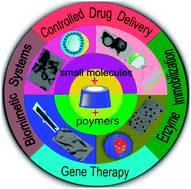
Chem. Commun., 2014,50, 11083-11092
https://doi.org/10.1039/C4CC03131H
Protein-based supramolecular polymers: progress and prospect
This feature article highlights recent advances and future trends in protein-based supramolecular polymers that are formed by various non-covalent interactions.

Chem. Commun., 2014,50, 9997-10007
https://doi.org/10.1039/C4CC03143A
Multiple interfaces in self-assembled breath figures
Progress in the breath figure method is reviewed by emphasizing the role of the multiple interfaces and the applications of honeycomb films in separation, biocatalysis, biosensing, templating, stimuli-responsive surfaces and adhesive surfaces.
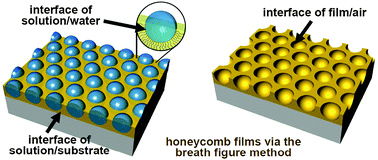
Chem. Commun., 2014,50, 4024-4039
https://doi.org/10.1039/C3CC49826C
Quantifying chloride binding and salt extraction with poly(methyl methacrylate) copolymers bearing aryl-triazoles as anion receptor side chains
Copolymers of methyl methacrylate and aryl-triazole based anion receptors were quantitatively analyzed.

Chem. Commun., 2014,50, 13285-13288
https://doi.org/10.1039/C4CC03362K
Dual effect of thiol addition on fluorescent polymeric micelles: ON-to-OFF emissive switch and morphology transition
Reaction with a thiol causes solution-state self-assembled block copolymer nanoparticles to undergo a simultaneous morphology transition from micelles to vesicles coupled to an ON-to-OFF switch in particle fluorescence.
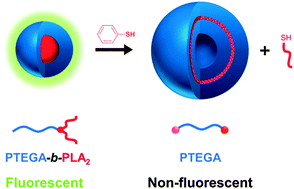
Chem. Commun., 2014,50, 11492-11495
https://doi.org/10.1039/C4CC04713C
Multivalent hydrogen bonding block copolymers self-assemble into strong and tough self-healing materials
ABA triblock copolymers with glassy PMMA middle blocks and dynamic hydrogen bonding terminal blocks self-assemble into nanocomposites having an excellent combination of mechanical strength and self-healing capability.
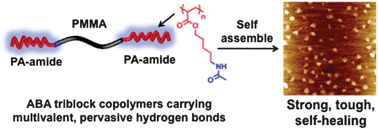
Chem. Commun., 2014,50, 10868-10870
https://doi.org/10.1039/C4CC03168G
Bicomponent hydrogen-bonded nanostructures formed by two complementary molecular Landers on Au(111)
One- and two-dimensional structures formed by two Lander molecules on Au(111) via 3D-optimized or complementary triple H-bonding are studied by scanning tunneling microscopy and rationalized by numerical calculations.
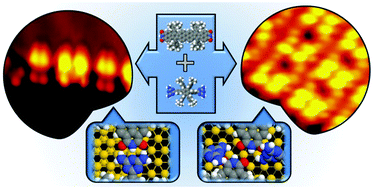
Chem. Commun., 2014,50, 10619-10621
https://doi.org/10.1039/C4CC03550J
Transforming polyethylenimine into a pH-switchable hydrogel by additional supramolecular interactions
Polyethylenimine, a liquid polymer, can be transformed into a dual pH-responsive hydrogel upon functionalization with a self-complementary zwitterion which introduces additional supramolecular crosslinks, but only around neutral pH.
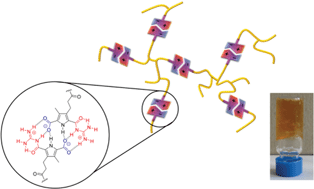
Chem. Commun., 2014,50, 10464-10467
https://doi.org/10.1039/C4CC03281K
Construction of supramolecular hyperbranched polymers via the “tweezering directed self-assembly” strategy
A bis-alkynylplatinum(II) terpyridine tweezer–alkynylgold(III) diphenylpyridine guest is shown to maintain a specific complexation in the presence of a B21C7–secondary ammonium salt recognition motif, which facilitates the formation of supramolecular hyperbranched polymers via a “tweezering directed self-assembly” strategy.
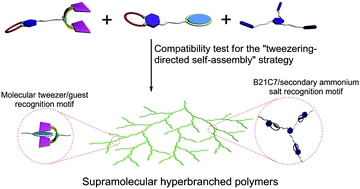
Chem. Commun., 2014,50, 9477-9480
https://doi.org/10.1039/C4CC03158J
pH-responsive inorganic–organic hybrid supramolecular hydrogels with jellyfish-like switchable chromic luminescence
A novel hybrid hydrogel, based on electrostatic co-assembly of polyoxometaltate and the ABA triblock copolymers shows both sol–gel transition and luminescence variation in response to pH change.
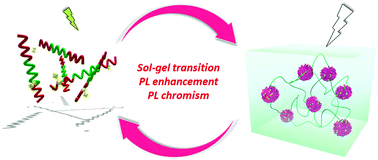
Chem. Commun., 2014,50, 9333-9335
https://doi.org/10.1039/C4CC04000G
Nucleobase-functionalized ABC triblock copolymers: self-assembly of supramolecular architectures
RAFT polymerization afforded acrylic ABC triblock copolymers with self-complementary nucleobase-functionalized external blocks and a low-Tg soft central block.
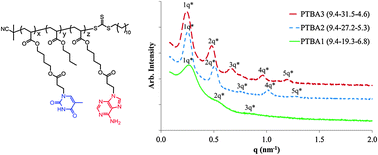
Chem. Commun., 2014,50, 9145-9148
https://doi.org/10.1039/C4CC03363A
Controllable aggregation-induced emission based on a tetraphenylethylene-functionalized pillar[5]arene via host–guest recognition
A novel TPE-functionalized pillar[5]arene (TPEP5) was successfully synthesized, and the motion of the TPE motif was restricted via pillararene-based host–guest recognition-mediated cross-linking, resulting in the efficient “turn-on” of fluorescence emission based on the AIE mechanism.
![Graphical abstract: Controllable aggregation-induced emission based on a tetraphenylethylene-functionalized pillar[5]arene via host–guest recognition](/en/Image/Get?imageInfo.ImageType=GA&imageInfo.ImageIdentifier.ManuscriptID=C4CC03127J&imageInfo.ImageIdentifier.Year=2014)
Chem. Commun., 2014,50, 9122-9125
https://doi.org/10.1039/C4CC03127J
A CO2- and temperature-switchable “schizophrenic” block copolymer: from vesicles to micelles
The block copolymers self-assemble in aqueous solution and the polymer assemblies undergo “schizophrenic” micelle to vesicle morphological transition under CO2 and temperature as triggers.
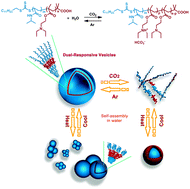
Chem. Commun., 2014,50, 8958-8961
https://doi.org/10.1039/C4CC03156C
Temperature-responsive telechelic dipalmitoylglyceryl poly(N-isopropylacrylamide) vesicles: real-time morphology observation in aqueous suspension and in the presence of giant liposomes
Telechelic dipalmitoylglyceryl PNIPAM vesicles fuse at the CP and form hybrid vesicles with phospholipid liposomes.
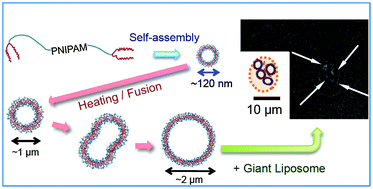
Chem. Commun., 2014,50, 8350-8352
https://doi.org/10.1039/C4CC03199G
A complex of poly(4-vinylpyridine) and tolane based hemi-phasmid benzoic acid: towards luminescent supramolecular side-chain liquid crystalline polymers
A luminescent supramolecular polymer based on P4VP and a tolane based hemi-phasmid benzoic acid forms Sm and Colh phases at different compositions and the luminescent properties depend on the phase structures.
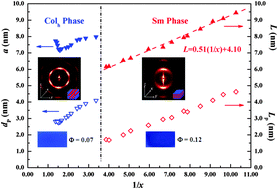
Chem. Commun., 2014,50, 8378-8381
https://doi.org/10.1039/C4CC03113J
Large-scale dissipative particle dynamics simulations of self-assembled amphiphilic systems
GPU-accelerated dissipative particle dynamics has been explored to probe the self-assembly of amphiphilic molecules in a soft confined environment.
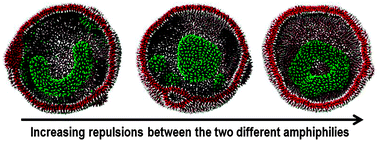
Chem. Commun., 2014,50, 8306-8308
https://doi.org/10.1039/C4CC03096F
Tuning the thermosensitive properties of hybrid collagen peptide–polymer hydrogels
Collagen peptide, PEG-based hydrogels with tuneable thermosensitive properties are validated as stimuli-responsive materials.
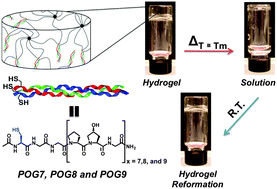
Chem. Commun., 2014,50, 8174-8176
https://doi.org/10.1039/C4CC03171G
A series of blue supramolecular polymers with different counterions for polymer light-emitting diodes
A series of blue supramolecular polymers with different counterions based on host–guest interactions were developed for polymer light-emitting diodes.
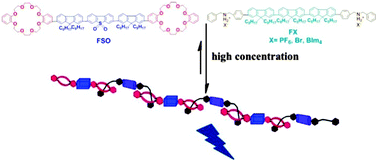
Chem. Commun., 2014,50, 8227-8230
https://doi.org/10.1039/C4CC03080J
Stimuli-responsive blue fluorescent supramolecular polymers based on a pillar[5]arene tetramer
Tetraphenylethene-functionalized pillarenes form stimuli-responsive blue fluorescent polymers and gels with neutral guest linkers, through the formation–deformation of A4/B2-type supramolecular polymers.
![Graphical abstract: Stimuli-responsive blue fluorescent supramolecular polymers based on a pillar[5]arene tetramer](/en/Image/Get?imageInfo.ImageType=GA&imageInfo.ImageIdentifier.ManuscriptID=C4CC03105A&imageInfo.ImageIdentifier.Year=2014)
Chem. Commun., 2014,50, 8231-8234
https://doi.org/10.1039/C4CC03105A
One-pot synthesis of nanocaterpillar structures via in situ nanoparticlization of fully conjugated poly(p-phenylene)-block-polythiophene
1D nanocaterpillar structures were spontaneously formed during the synthesis of fully conjugated poly(2,5-dihexyloxy-1,4-phenylene)-block-polythiophene due to the strong π–π interactions between the polythiophene blocks.
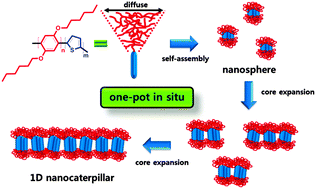
Chem. Commun., 2014,50, 7945-7948
https://doi.org/10.1039/C4CC02787F
“Soldier–Sergeant–Soldier” triblock copolymers: revealing the folded structure of single-chain polymeric nanoparticles
“Sergeant-and-Soldiers” experiments were performed on single-chain polymeric nanoparticles (SCPNs) with an ABA-type triblock architecture that gives information about the folding structure of the SCPNs.
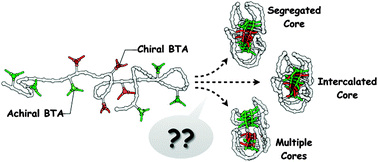
Chem. Commun., 2014,50, 7990-7993
https://doi.org/10.1039/C4CC02789B
The construction of rigid supramolecular polymers in water through the self-assembly of rod-like monomers and cucurbit[8]uril
Two types of stick-like supramolecular polymers possessing rigid backbones have been fabricated through the self-assembly of rod-like monomers and cucurbit[8]uril in water.
![Graphical abstract: The construction of rigid supramolecular polymers in water through the self-assembly of rod-like monomers and cucurbit[8]uril](/en/Image/Get?imageInfo.ImageType=GA&imageInfo.ImageIdentifier.ManuscriptID=C4CC02971B&imageInfo.ImageIdentifier.Year=2014)
Chem. Commun., 2014,50, 7982-7985
https://doi.org/10.1039/C4CC02971B
Dual pH-triggered multistage drug delivery systems based on host–guest interaction-associated polymeric nanogels
The multistage polymeric nanogel delivery systems were constructed via host–guest interactions, which showed tumor acidity-triggered disassembly into smaller nanoparticles for deep tissue penetration, high-efficiency cellular uptake, and intracellular endo-lysosomal pH-responsive drug release.
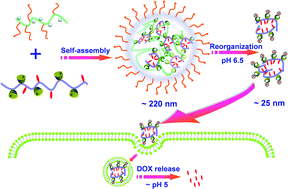
Chem. Commun., 2014,50, 7824-7827
https://doi.org/10.1039/C4CC03120B
Formation of a “pseudosuitane”-type complex between a triptycene-derived bis(crown ether) host and 1,1′-(anthracene-9,10-diyl)bis(N-benzylmethanaminium): a new method for the synthesis of linear polyrotaxanes
Formation of a “pseudosuitane”-type complex based on triptycene-derived bis(crown ether) provides a new method for the synthesis of linear polyrotaxanes.
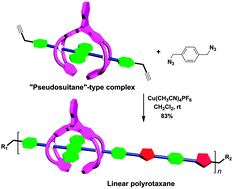
Chem. Commun., 2014,50, 7611-7613
https://doi.org/10.1039/C4CC02904F
Synthesis of monodisperse nanocolloidal microspheres with controlled size by vesicle bilayer templating
Uniform PS colloidal particles with controllable size ranging from 60 to 150 nm were prepared on a mass scale by using the bilayers of hyperbranched polymer vesicles as templates.
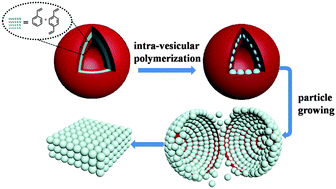
Chem. Commun., 2014,50, 7363-7366
https://doi.org/10.1039/C4CC02520B
A photochromic supramolecular polymer based on bis-p-sulfonatocalix[4]arene recognition in aqueous solution
A photochromic supramolecular polymer was fabricated via bis-p-sulfonatocalix[4]arene recognition, showing colour switching and morphology change under alternative UV/Vis light stimuli.
![Graphical abstract: A photochromic supramolecular polymer based on bis-p-sulfonatocalix[4]arene recognition in aqueous solution](/en/Image/Get?imageInfo.ImageType=GA&imageInfo.ImageIdentifier.ManuscriptID=C4CC02672A&imageInfo.ImageIdentifier.Year=2014)
Chem. Commun., 2014,50, 7166-7168
https://doi.org/10.1039/C4CC02672A
Photoresponsive supramolecular self-assembly of monofunctionalized pillar[5]arene based on stiff stilbene
We reported a photoresponsive monofunctionalized pillar[5]arene based on stiff stilbene. Z-1 tends to form self-complexing [1]pseudorotaxanes and [c2] daisy chains, whereas E-1 forms supramolecular polymers.
![Graphical abstract: Photoresponsive supramolecular self-assembly of monofunctionalized pillar[5]arene based on stiff stilbene](/en/Image/Get?imageInfo.ImageType=GA&imageInfo.ImageIdentifier.ManuscriptID=C4CC02760D&imageInfo.ImageIdentifier.Year=2014)
Chem. Commun., 2014,50, 7001-7003
https://doi.org/10.1039/C4CC02760D
Intramolecular folding of triblock copolymers via quadrupole interactions between poly(styrene) and poly(pentafluorostyrene) blocks
The self-assembly of a synthetic triblock copolymer was used to mimic the β-hairpin formation.
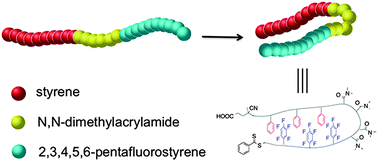
Chem. Commun., 2014,50, 6225-6227
https://doi.org/10.1039/C4CC01840K
Towards covalent organic frameworks with predesignable and aligned open docking sites
Covalent organic frameworks were developed to hold predesignable and aligned binding sites on the channel walls for supramolecular architecture.

Chem. Commun., 2014,50, 6161-6163
https://doi.org/10.1039/C4CC01825G
Three-component vesicle aggregation driven by adhesion interactions between Au nanoparticles and polydopamine-coated nanotubes
Large-scale and robust vesicle aggregates were obtained through three-component molecular recognition among cell-sized polymer vesicles, carbon nanotubes and Au nanoparticles driven by adhesion interactions between Au and polydopamine.
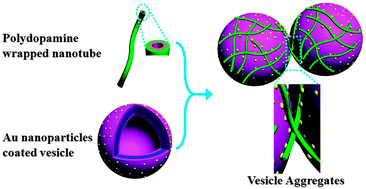
Chem. Commun., 2014,50, 6157-6160
https://doi.org/10.1039/C4CC00609G
A hybrid porous material from a pillar[5]arene and a poly(ionic liquid): selective adsorption of n-alkylene diols
A macro-/mesoporous polymeric network was prepared via ionic complexation between a polymerized ionic liquid and carboxylated pillar[5]arene. It was successfully applied as a selective absorbent for n-alklyene diols.
![Graphical abstract: A hybrid porous material from a pillar[5]arene and a poly(ionic liquid): selective adsorption of n-alkylene diols](/en/Image/Get?imageInfo.ImageType=GA&imageInfo.ImageIdentifier.ManuscriptID=C3CC49108K&imageInfo.ImageIdentifier.Year=2014)
Chem. Commun., 2014,50, 2595-2597
https://doi.org/10.1039/C3CC49108K
About this collection
This ChemComm themed collection celebrates recent achievements in the development of more complex architectures, exploration of novel building blocks, the reversible assembly and disassembly behavior of these constructs, alongside the development of advanced characterization methods, through to the potential applications of these novel polymeric self-assembles. It covers not only assemblies prepared from polymeric building blocks but also supramolecular polymers made from small organic molecules via noncovalent interactions. The issue is Guest Edited by Professors Feihe Huang, Rachel O’Reilly and Steve Zimmerman. New articles will be added to this collection as they are published.